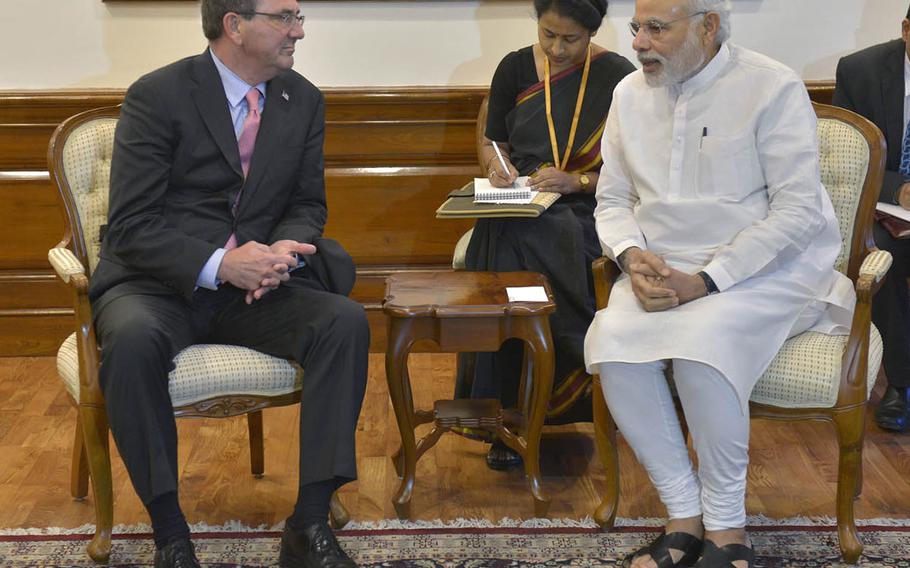
Secretary of Defense Ash Carter, left, meets with Indian Prime Minister Narendra Modi in June in New Delhi, India. Defense relations between the U.S. and India have never been stronger, analysts say. (DOD)
Indian Prime Minister Narendra Modi isn’t the highest-profile dignitary visiting the United States this week.
But while Pope Francis and Chinese President Xi Jinping are stealing the headlines, Modi’s meetings in Washington are far from insignificant, given his country’s massive population, growing economy and strategic location.
Plus, defense cooperation between the U.S. and India has never been brighter.
“I think it’s extremely safe to say that our defense relations are better than they ever have been,” said Richard M. Rossow, an India expert at the Center for Strategic and International Studies, a think tank in Washington. “We’ve got somewhere between $10 billion to $15 billion in defense sales, and we’ve got joint exercises across all of our forces. We even have some growing cooperation in humanitarian assistance and disaster relief.”
This week, India’s Cabinet approved a $2.5 billion deal to buy 22 Apache attack helicopters and 15 Chinook helicopters from the U.S., beating out rival arms supplier Russia. And on the distant horizon is the American promise to share with India its top technology for aircraft carriers and jet engines. Next month, India will host a beefed-up exercise that will include ships from the U.S. and Japan.
Both Modi and President Barack Obama are fond of noting that their countries are “natural allies” because of shared values, but technology transfer is a key factor in India’s warming to U.S. overtures on defense cooperation, said Phunchok Stobdan, a senior fellow at the Institute for Defence Studies and Analyses in New Delhi.
“At the end of the day, what the Indians are looking for is ‘Made in India,’ ” he said. “They want to manufacture everything.”
India has long possessed a defense industry, but it’s been dominated by state-owned companies that have not been competitive, Rossow said. “They have not been able to keep an edge over what others in the region have been able to develop.”
Several years ago, the U.S. offered India 17 “starter-level” defense technologies — such as the small, tabletop Raven drone and a chemical hazard suit — that could receive quick export approval by the U.S. government, Rossow said. But India was more interested in getting things that were top of the line from the beginning, and the offer languished, he said.
“We broke the logjam when we started talking about what [technologies] would be beyond those, which are aircraft carriers and jet engine technology,” he said.
A carrier working group comprising top-level officials from both countries met for the first time last month in Washington, but Rossow said a timeline for transferring these two technologies has not been made known.
Richard Verma, America’s ambassador to India, offered a broad time frame during a talk earlier this month at the East-West Center in Honolulu.
“At some point in the next decade, India will launch its next generation of aircraft carrier, and the United States will have played a direct role in its construction,” he said.
The defense relationship has grown because the nations face similar challenges over terrorism, piracy and access to shipping lanes, Verma said.
“It’s only natural that in this century — when you are looking around for partners to help uphold this post-World War II security cooperation that India and the United States seek to protect — that U.S.-India security cooperation makes so much sense,” he said.
Verma was adamant that the growing military cooperation is not primarily aimed at China, an opinion defense analysts generally agree on.
“I don’t believe it has nothing to do with China,” Rossow said. “But I don’t think it has only to do with China.”
Shayam Tekwani, an associate professor at the Asia-Pacific Center for Security Studies in Honolulu, added, “The truth is neither country would want to complicate its delicate diplomatic strategy and growing economic relationship with China.”
India adhered to a policy of nonalignment during the long Cold War between the U.S. and the Soviet Union, refusing to choose sides, a foreign policy advanced by the left-leaning Indian National Congress political party. The right-leaning Bharatiya Janata Party swept into power with the 2014 elections, making Modi prime minister and forming a government that has been much more interested in deepening its U.S. ties.
Some in India see the rivalry between America and China as a potential benefit, Stobdan said.
“If China could gain in the past from the U.S.-Soviet conflict, I’m sure the Indians could make the same gains in terms of conflict between China and the United States,” he said.
But India faces some challenges regarding China that have little to do with American calculations.
A decadeslong border dispute in the northeastern state of Arunachal Pradesh remains unsettled, with troops frequently crossing paths. India has experienced cyberattacks that have been attributed to Chinese hackers. China has lavished money on India’s closest neighbors — Bangladesh, Nepal, Sri Lanka and Myanmar — in an effort to draw them into its orbit.
Perhaps the greatest area of concern is the upsurge of activity in the Indian Ocean by China’s navy, which docks submarines in Sri Lanka and Pakistan, Rossow said.
“[India’s] not getting involved in our disputes with China; they’ve got their own areas of concern,” he said.
olson.wyatt@stripes.com Twitter: @WyattWOlson